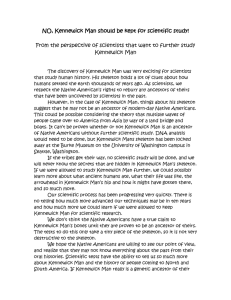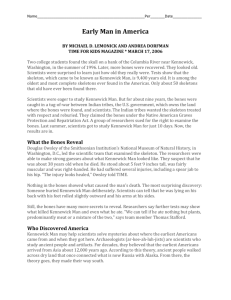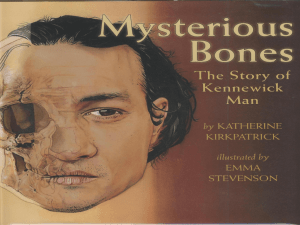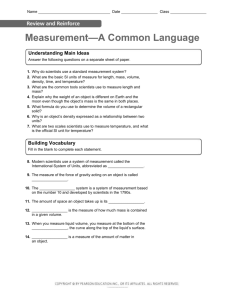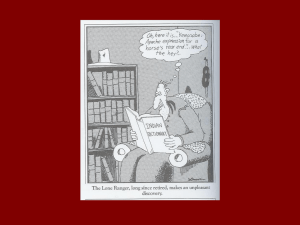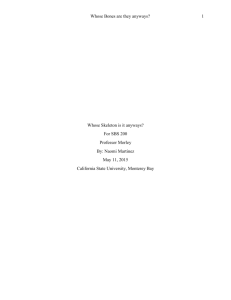Kennewick Man Author POV Analysis
advertisement
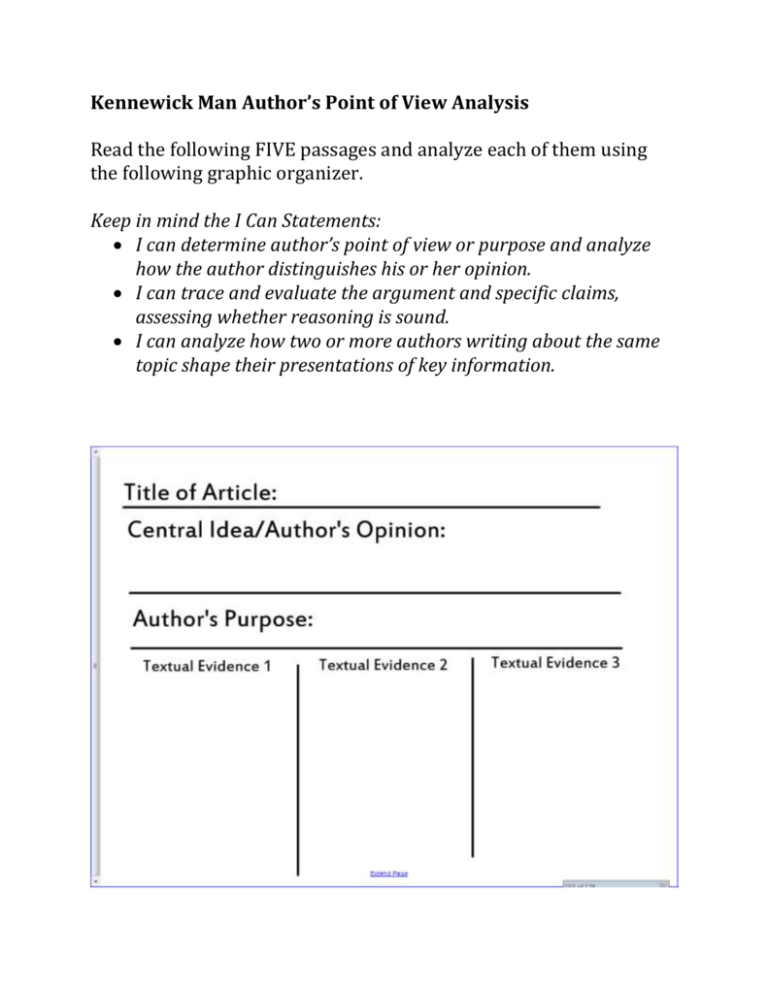
Kennewick Man Author’s Point of View Analysis Read the following FIVE passages and analyze each of them using the following graphic organizer. Keep in mind the I Can Statements: I can determine author’s point of view or purpose and analyze how the author distinguishes his or her opinion. I can trace and evaluate the argument and specific claims, assessing whether reasoning is sound. I can analyze how two or more authors writing about the same topic shape their presentations of key information. Why do scientists want to study Kennewick Man? C. Loring Brace Curator of Biological Anthropology and Professor of Anthropology, University of Michigan The questions "Why do scientists want to study Kennewick Man" and "What would I personally hope to learn from the study of Kennewick Man" are essentially the same from my point of view. The Kennewick skeleton is one of the oldest and most complete human specimens found in the Western Hemisphere and the only one from the northwest edge of the continent, which was almost certainly close to the route taken by the earliest humans to enter the continent. All the archeological and biological evidence points to a Northeast Asian origin for the original human occupants of the Western Hemisphere, but there is increasing reason to believe that different entrants came at different times and derived from different Asian sources. Who were those sources? When did their offshoots come to the Americas? And which Native Americans are derived from which of those sources? Only by studying the remains of the earliest Americans and comparing them to recent and living Native Americans and to recent Asians can we ever provide answers to these questions. While Cohanim priests can trace their male lineage back several thousand years using Ychromosome analysis, no one alive today can trace his or her heritage back as far as the 9,000-year-old Kennewick Man. Just because some government officials claim that any ancient skeleton is Native American by their definition does not justify turning it over to one or more groups of modern Native Americans, who may have no close relationship (or any at all) to the skeleton. The old European-American assumption that "if you've seen one Indian, you've seen them all" is a gross misrepresentation of reality. Although both the Navajo and the Hopi are Native American groups in the American Southwest, when Harvard University returned the burials from Pecos Pueblo that had been in the Peabody Museum in Cambridge, Massachusetts, it did not turn those skeletons over to the Navajo but only to Pueblo groups related to the Hopi, because in that particular case, the historical knowledge of who was related to whom was known. In the case of Kennewick, however, such information is not known. In Polynesia, oral traditions preserve a general knowledge of population relationships going back some 2,000 years. Where written records are kept, one can trace actual relationships back even further than that, as with the descendants of Confucius. Ychromosome records have shown the continuity of the Cohanim, the Jewish priesthood, via the founding priests of migrant Jewish settlements. But none of these forms of evidence goes back as far in time as the date of Kennewick Man or the roots of the initial settlers in the New World. If we simply bury the evidence, we will never be able to answer the questions of origins and relationships. Skeletal Remains are a Valuable Source of Scientific Information George W. Gill Professor of Anthropology, University of Wyoming Why do we feel we should be able to study Kennewick Man? Ancient human skeletal remains are a valuable source of scientific information and are protected as archeological resources under federal law (the Archaeological Resources Protection Act). As a trained physical anthropologist at a state institution, I have the legal and ethical responsibility to curate, study, protect, and sometimes repatriate the human skeletons that come to my laboratory. From human skeletons, we can derive information relating to human diseases, injury, warfare, origins, migrations, and gene flow. The more ancient skeletons as well as the better preserved ones tend to be more important skeletons scientifically because of the vast amount of new information that they can provide. Kennewick Man may be one of the most important skeletons ever unearthed in North America. It is a very ancient skeleton and therefore not a close relative of any human alive today. Thus, claims of cultural or biological affinity by any group existing today are so tenuous that they should not be allowed to prevent scientific study of this important find. The skeleton should remain in the domain of all humanity and not be claimed by any single federal agency or any single religious or cultural group. It should be studied by all qualified scientists whose research might be able to provide new knowledge from the secrets that these ancient bones contain. Kennewick Man, whose reconstructed skull is shown here, should remain in the public domain, Gill feels. What do I personally expect to learn from studying the Kennewick skeleton? I am a forensic anthropologist with a research focus on skeletal race attribution (learning ancestry from bone traits). Most of the successful methods that I have developed and published in leading journals relate to distinguishing American Indians from whites skeletally. Certain single approaches are over 90 percent accurate in separating modern whites from modern American Indians. Interestingly, traits of both of these populations are found among individuals of the early Archaic and Paleo-Indian period. Certainly the Kennewick skeleton should be assessed with regard to these trait occurrences. These are not the multivariate, cranial-measurement approaches used by most other physical anthropologists who study ancestry. They constitute a somewhat independent approach. My approach would provide another independent means of determining ancestry through a combination of different kinds of trait evaluations. In short, my approach will hopefully provide us with insight to help answer the question of who Kennewick Man's closest relatives were in regard to the major racial elements of today. Claims for the Remains D. Gentry Steele Department of Anthropology, Texas A&M University I strongly believe in the importance and value of the scientific examination of our earliest prehistoric ancestors. Today's study of humanity's natural history has clearly documented the decency of human conquest of the last of Earth's landmasses. While we can trace our human lineage more than two million years back in time, the colonization of the New World, and the islands of the Pacific Rim—the last chapters in our global dispersal—are relatively much more recent events, having occurred within the last several thousand years in the case of the Pacific islands. The actions of these last pioneers were inexorably interwoven with and dependent upon those who went before, and because of this, are an integrated part of our life history. When and how the last of the Earth's landmasses were occupied, by whom, and how the processes of biological change marked humanity's last global pioneers are questions of interest to all. I also strongly believe that understanding our shared life history will ultimately help us appreciate our commonality. Without scientific investigation of early remains such as Kennewick Man (part of whose skull is shown above), we would have no knowledge of our prehistory, Steele maintains. The recovery and interpretation of our prehistory has been accomplished through scientific investigation of those biological and cultural remains that have survived the erosion of time. Without the scientific investigation of this first line of evidence, we would have no knowledge of our prehistory, yet the most ancient remains are too few, and typically incomplete or even fragmentary. Because we view our ancient past through the destructive filter of time, each new site where human remains are recovered is of incalculable importance. Therefore, the scientific study of remains such as Kennewick Man, Wizard's Beach, and Spirit Cave should be thorough, carefully done, and verified by other scholars. Verifying our analyses is the foundation upon which all science is built. Without verification, the analyses are suspect at best, and at worst, ignored. This process of verification does not imply a lack of confidence in the work of the initial scholars. Rather, it is recognition that scientists gather and interpret scientific evidence within the context of a particular theoretical framework and perspective. Verification of a scientist's studies provides assurance that data supportive of alternative interpretations are gathered. Without this verification, scientific analysis is incomplete. Former Tribal Chair Questions Scientists' Motives and Credibility By Don Sampson (former) Board of Trustees Chairman for the Confederated Tribes of the Umatilla Indian Reservation\ November 21, 1997 Most American Indians do not appreciate having the graves of our ancestors disturbed and their remains dissected and studied in the name of science. This practice, generally supported by non-Indian society, has come to the forefront over the past year and a half with the unearthing of a skeleton near present-day Kennewick, Washington. The media and the public have come to know this individual as Kennewick Man. We have tried to explain to the public and scientists that our religious and cultural beliefs mandate that we rebury the remains of this individual as soon as possible. Many people don’t seem to care about, or respect, our religious beliefs. So, rather than present those points again, I will take this opportunity to briefly address some of the scientific issues of this case. We do not believe the issues surrounding this case are, in any manner, related to scientific facts. Rather, the issues are the result of an effort of a small group of scientists, through a media campaign, to lay claim to materials which Congress did not intend they have. In their media campaign, the scientists have led the public to believe they can produce considerable data by studying this individual, including knowledge of the earliest peoples of this continent. In an article published last summer in The New Yorker magazine, scientists claim they already know a great deal about Kennewick Man. They think he may have been a fisherman who ate lots of salmon, that he was probably a tall, good-looking man, slender and well proportioned, that he was part of a small band of people who moved about, hunting, fishing, and gathering wild plants, that he may have lived in a simple sewn tent or mat hut, and that he may have worn tailored clothing. The federal court, the Corps of Engineers, and the public should be asking the scientists to demonstrate how they can tell these things. These descriptions of the scientific "knowledge" obtained by the scientists is purely speculation and hypothesis, and do not advance our knowledge of this person, or mankind, a single bit. Almost anyone seeing an old skeleton in that area could have reached the same conclusions without destructive tests like the scientists want to perform. These scientists are alleging that racial origins can be determined by examining the skeleton. But it is common knowledge among good anthropologists that it is impossible to determine the so-called "race" of an individual. A sample group is needed so that common traits can be determined. The Kennewick Man remains were examined by Dr. Grover Krantz and there have been indications, using outdated techniques, that the skull has some "Caucasoid" features, some "Native American" features and a "Negroid" feature. Even following the 19th century science used by Dr. Krantz, there are 3 possible origins. Dr. Grover Krantz has been regarded primarily as an expert on the "Big Foot" or "Sasquatch." From what we understand, his research is regarded by many of his colleagues as far from the mainstream of anthropology. We also question the credibility and methodology of other scientists involved in the initial studies of Kennewick Man. Why hasn’t a detailed report been compiled from those initial studies? Where is the statement of work and description of the methodology used? Were the studies conducted in accordance with the Archaeological Resources Protection Act (ARPA) as they should have been? The "scientific case" for requiring the U.S. Army Corps of Engineers to allow testing of these remains is, in our viewpoint, shaky to non-existent. We want the public and scientists to understand that we do not reject science. In fact, we have anthropologists and other scientists on staff, and we use science every day to help in protecting our people and the land. However, we do reject the notion that science is the answer to everything and therefore it should take precedence over the religious rights and beliefs of American citizens. Donald Sampson served as Chairman of the Board of Trustees for the Confederated Tribes of the Umatilla Indian Reservation from 1993 to Dec. 1997, when he decided not to run for re-election. He has a Bachelor’s of Science Degree from the University of Idaho. Human Remains Should Be Reburied By Armand Minthorn Board of Trustees member and religious leader with the Confederated Tribes of the Umatilla Indian Reservation Sept. 1996 In the summer of 1996 a human burial, believed to be about 9,000 years old, was discovered near Columbia Park in Kennewick, Washington. Scientists and others want to study this individual. They believe that he should be further desecrated for the sake of science, and for their own personal gain. The people of my tribe, and four other affected tribes, strongly believe that the individual must be re-buried as soon as possible. My tribe has ties to this individual because he was uncovered in our traditional homeland -- a homeland where we still retain fishing, hunting, gathering, and other rights under our 1855 Treaty with the US Government. Like any inadvertent discovery of ancestral human remains, this is a very sensitive issue for me and my tribe. Our religious beliefs, culture, and our adopted policies and procedures tell us that this individual must be re-buried as soon as possible. Our elders have taught us that once a body goes into the ground, it is meant to stay there until the end of time. It is not our practice to publicize these types of discoveries, both for the protection of the individual as well as sensitivity to our tribal members. In this case, however, we must take the opportunity this incident has created to help educate the general public about the laws governing these discoveries and what these discoveries mean to us, as Indians. We also hope to give people a better understanding of why this is such a sensitive issue. The Native American Graves Protection and Repatriation Act (NAGPRA) and Archaeological Resources Protection Act (ARPA), as well as other federal and state laws, are in place to prevent the destruction of, and to protect, human burials and cultural resources. The laws also say that authorities must notify affected Tribes and consult with tribal officials on how to handle the discovery, as well as protection and preservation. Our Tribe was not properly notified and if we had been, this difficult situation might have been avoided. Under the Native American Graves Protection and Repatriation Act, tribes are allowed to file a claim to have ancestral human remains reburied. My tribe has filed a claim for this individual and when it is approved, we will rebury him and put him back to rest. In filing this claim, we have the support of the four other tribes who potentially have ties to this individual. These tribes are the Yakama, Nez Perce, Colville, and Wanapum. We share the same religious belief, traditional practices, as well as oral histories that go back 10,000 years. If this individual is truly over 9,000 years old, that only substantiates our belief that he is Native American. From our oral histories, we know that our people have been part of this land since the beginning of time. We do not believe that our people migrated here from another continent, as the scientists do. We also do not agree with the notion that this individual is Caucasian. Scientists say that because the individual’s head measurement does not match ours, he is not Native American. We believe that humans and animals change over time to adapt to their environment. And, our elders have told us that Indian people did not always look the way we look today. Some scientists say that if this individual is not studied further, we, as Indians, will be destroying evidence of our own history. We already know our history. It is passed on to us through our elders and through our religious practices. Scientists have dug up and studied Native Americans for decades. We view this practice as desecration of the body and a violation of our most deeply-held religious beliefs. Today thousands of native human remains sit on the shelves of museums and institutions, waiting for the day when they can return to the earth, and waiting for the day that scientists and others pay them the respect they are due. Our tribal policies and procedures, and our own religious beliefs, prohibit scientific testing on human remains. Our beliefs and policies also tell us that this individual must be re-buried as soon as possible. Our religion and our elders have taught us that we have an inherent responsibility to care for those who are no longer with us. We have a responsibility to protect all human burials, regardless of race. We are taught to treat them all with the same respect. Many people are asking if there’s any chance for a compromise in this issue. We remind them that not only has this individual already been compromised, but our religious beliefs have once again been compromised. Many nonIndians are looking for a compromise -- a compromise that fits their desires. And, many non-Indians are trying to bend the laws to fit their desires. The Native American Graves Protection and Repatriation Act was passed by Congress in 1990 to protect Native American burials and set in place a mechanism to have human remains and artifacts returned to the tribes. We are trying to ensure that the federal government lives up to its own laws, as well as honoring our policies, procedures, and religious beliefs. We understand that non-Indian cultures have different values and beliefs than us, but I ask the American people to please understand our stance on this issue. We are not trying to be troublemakers, we are doing what our elders have taught us -- to respect people, while they’re with us and after they’ve become part of the earth.
